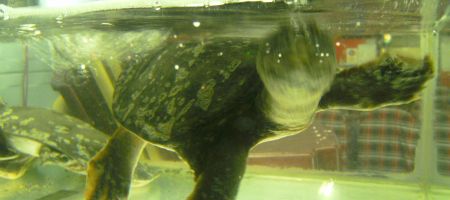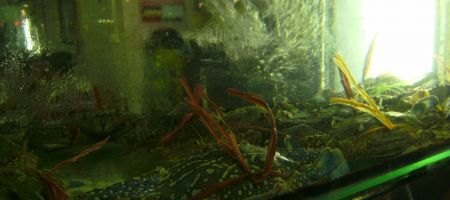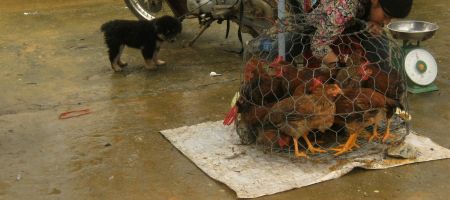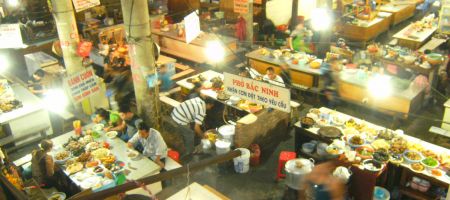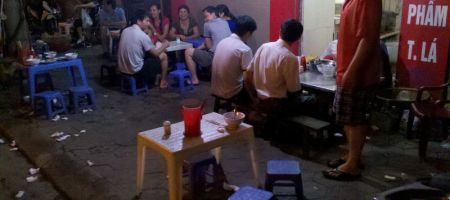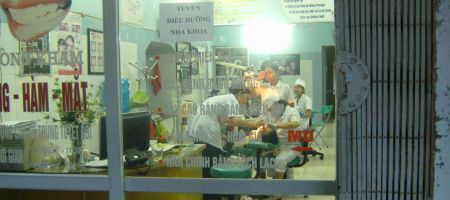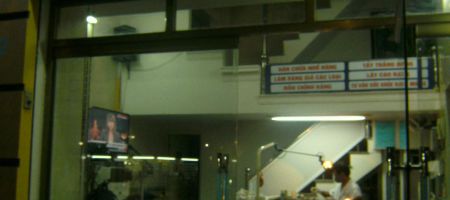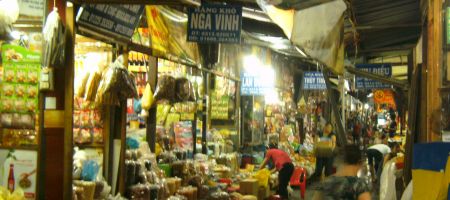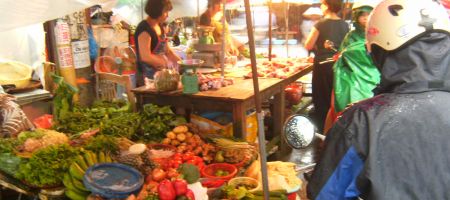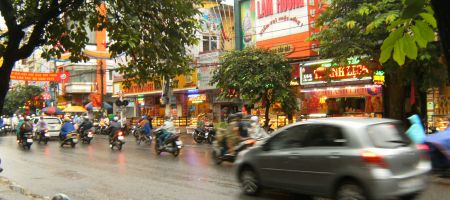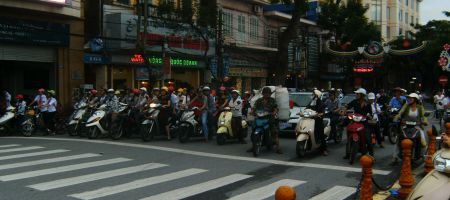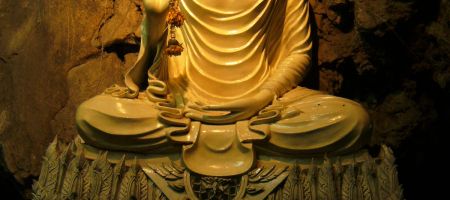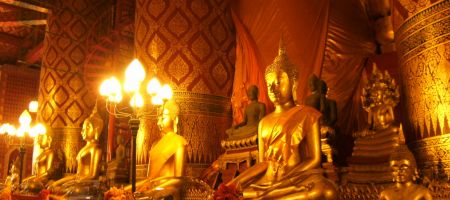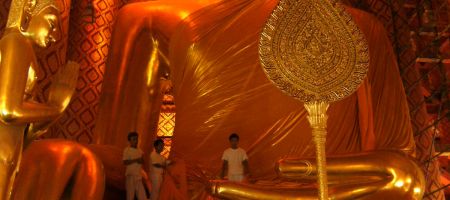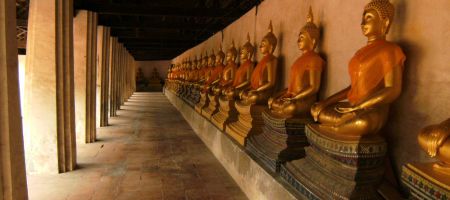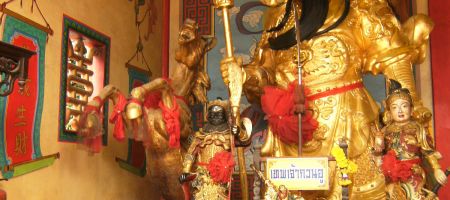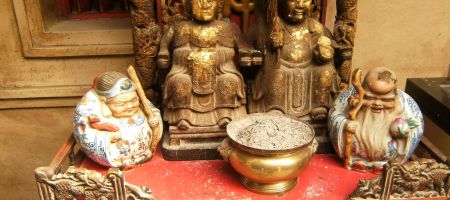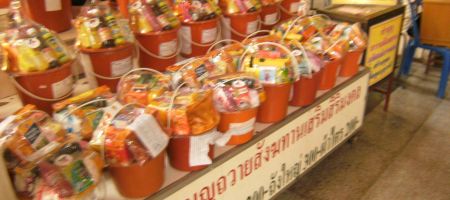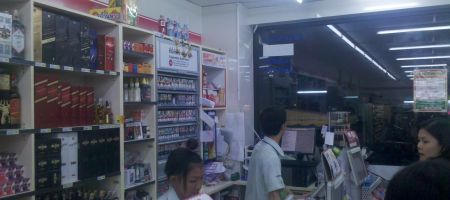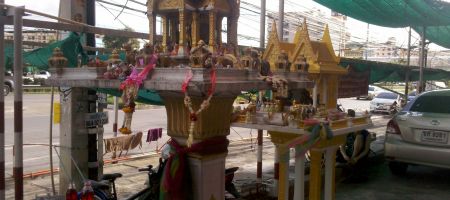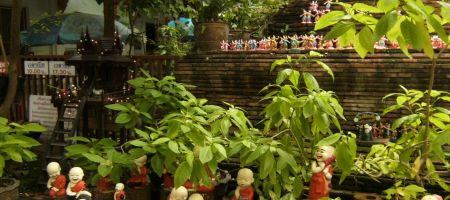Night train to Hue
I’m on a night train to Hue!
Comment [2]

Only one?
When I am ordering something in a restaurant, I often get this question, “only one?”. I normally answer it with “yes, I am just one person” but didn’t quite understand at first what they meant, as the thing I ordered was absolutely enough for me.
I found out that the Vietnamese always order several dishes, for example one portion of mixed rice and beef with sour vegetables. With the more people you come to the restaurant, the more different dishes you can order and share them amongst your friends.
So, going to the restaurant is quite the social thing here, often I see groups of 6-10 people at one table. This is similarly to Spain where people go out in the evenings to drink beer (and have tapas) in groups. Speaking of Spain, they also got beer here and it is even more watery than Spanish beer. Most people will drink “Bia Hoi” if available, fresh no-name draught beer that is said to be only good for a few days or so. It is incredibly cheap, one glass for about 5000Đ (~0.15€). (As opposed to bottled beer about 15.000Đ and up)
In the rear part of menus in many restaurants they offer whole chickens, whole piglets etc. The price for those dishes is not given because the price depends on how much they will have to pay for it on the market. Also popular is to order a hotpot for the group.
Another thing I can say about Vietnam is that the meat is fresh. Really fresh. Has-just-been-alive-fresh:
Seafood restaurants will have a wall of aquariums with live fish, turtles, shrimps and crayfish in front and especially in rural areas you will see cages with chicken or sometimes even piglets in front of the restaurant which they butcher then directly in the kitchen for you if you order a whole chicken.
Then, there is Phõ, very popular here. Lena loves it because “these soups don’t taste like anything”. I don’t because of the same reason.
A soup is cheap though, perhaps 10,000-20,000Đ (0.30-0.60€) and those soup-stalls will be one of the last things still open at night. These noodles are served in tiny stalls which consist of just a little stove on the pavement beside the street, have a look at the photo.
Also, note the tiny furniture on the photo. This is normal and the Vietnamese do have no problem to sit down there. Even in more proper (indoor) restaurants, the furniture will often be of the same height.
Otherwise, I can say that the Vietnamese are the kings of spring rolls. There are some variations and all are absolutely delicious.

Board game geeks
This article is part of a series. Check out part II.
I took the following picture in the harbour market district of Hai Phong:
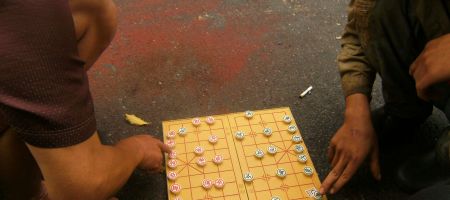
This game is played everywhere in Vietnam. It is a bit like chess but the pieces follow different rules. Interestingly, people play it a lot like this on the street, sometimes with a bunch of people standing around it and watching or discussing the next moves. Also, it is obviously played by the lower class, which I find remarkable.
Other popular games include poker and other card games, both of which are played in bars or on the street as well, sometimes with money, sometimes without.

That dodgy doctor
So, I had food poisoning last week, the whole programme. But I am better now.
After the second day of not feeling better, I decided to go back down the mountain into the biggest hospital in the whole Lao Cai province in the search for a doctor that can speak English. As I mentioned before, even amongst the literate crowd, it is not at all common to speak English.
On arriving there, I found out that nobody speaks English and no signs at all were in English (that could point me where to go inside the hospital). However, there was a man I initially identified as a tout or mototaxi-driver who could speak some English and was overly helpful to get me to a doctor.
Sceptically, I followed him and he arranged that I could see a doctor right away, a man who was coincidentally just coming into the hospital through the front door.
After taking my blood pressure, that doctor (who couldn’t speak English) wrote down some medicaments I should take while I had the impression that he was not listening to the man’s translation of the description of my symptoms.
The whole situation felt a bit dodgy and I was glad when I was back out of the hospital and the tout did not play any tricks on me.
But… what… wait a moment! He was just very nice and not a tout at all, he even arranged some private meeting with a doctor and for the whole thing I didn’t have to pay anything, only the medicaments at the hospital pharmacy.
They even called me a taxi back into town (the hospital is 8km out of town)! So, a lesson learned: People who mean it good with you here wear this kind of intrusive- and overhelpfulness as well, it is not a special treat of the touts and other people who want to get money out of you.
As a conclusion, here two pictures of dentists at work in Hai Phong:

Hello!
Did you know that Vietnamese start learning English in school when they are twelve? Same as in Germany. But still, their English is incredibly bad. Most can not even say more than “Hello” and “Where you from?”. Bargaining for the price will only happen with fingers or with a calculator to show the price. Only with few, it is possible to have a basic conversation in English. So to have a notebook and a pen is very useful for communication here.
A Vietnamese told me that in school, they learn only the grammar, not conversation. This is similar what I heard about Thailand. So they learn English like we learn Latin. Hey, let’s have a conversation in Latin, shall we? Hmm.. errr… alea acta est?
Analogous to the horn of motos, perhaps for the lack of the knowledge of other words, being greeted with “Hello” has more than one meaning:
“Hello! …Moto?” is one of them (no, not that one, Motorola isn’t even popular here!). Moto-taxis are really around every corner, even in non-touristic places it is hard to not be offered moto-rides (as an European) by just walking down a street. As those “taxis” are in every aspect just a guy with a moto and a second helmet, it is impossible to say how ad-hoc those taxis really are or if it is not really just some guy who sniffed an opportunity to get some cash. The Vietnamese are of the enterprising kind, so this isn’t far fetched.
Next one, is the “Hello” … “Buy something from mee!”. This happens in non-touristic places as well. Just walking though a local (e.g. food, textile) market and so much as blink at the wares or the shopkeeper is often enough to get this kind of attention. Yesterday it went like this: While walking past a raw textiles shop, the shopkeeper points at a random shop item and says “Buy this?” – “Err, no?”. Then he points at another random item, “Buy this?” – “No!”, another item “Buy this?”,… which went on until I just walked away.
So, many just start communication to entangle you in the webs of their shop, fluffing themselves that this kind of tactic would enhance their chances to sell you something. Does it? Not for me.
Now, even though I sometimes get the impression that everyone here in Vietnam (that shows interest in you) is trying to get as much money out of you as possible, most people that say “Hello” to you actually just want to say “Hello”. Not more, no conversation, just “Hello”: A moto that drives by: “Hello”, kids playing on the street, “Hello”, some guy on the street “Hello”. At first when somebody greeted me, I stopped, greeted back and stared at him, expecting a conversation. It was interesting to find out that many people really just want to say “Hello”, nothing more.
Regrettably, if it is a conversation, it often comes down to the other person wanting me to buy something. That is why I normally greet back but keep walking by now.
By the way, did you know that I am regarded as very handsome here? It is flattering to be complimented so often for ones looks. I will miss that when I am back in Germany ;-)
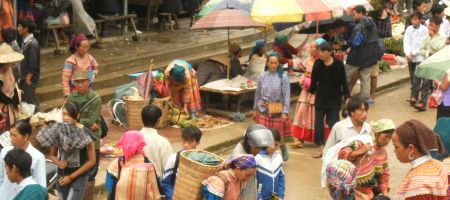
A scene in the Bac Ha market. Many Flower Hmong here.
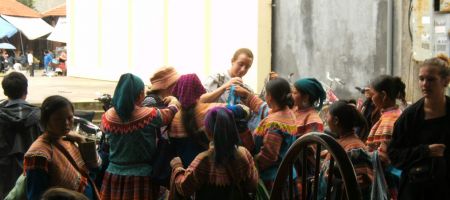
A game of catch the tourist! This couple made the mistake of showing a slight interest in the wares a street-seller was offering. In seconds, more street sellers were sniffing the possible cash.
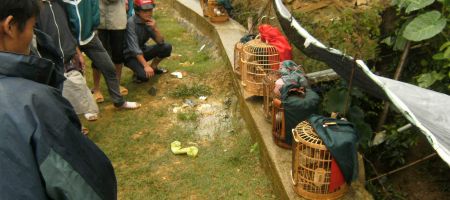
Animal market in Bac Ha. There is big trade with singing birds. Many shops, restaurants and families have singing-birds in their houses.

A horse for everybody
One of the first impressions I had when entering Vietnam was the different traffic situation as in Thailand:
Here in Vietnam, people sound their horn all the time, making the roads quite a noisy affair. Honking does cover use cases like “hello, here I am (I am driving on the same street as you on the opposite lane)”, “I am overtaking you”, “careful you, don’t overlook me while you pull out into traffic” or also “I am turning into a street and I’m not looking”. Buses horn to make themselves known so people waiting at the road for a bus can get to the road (there are no fixed bus stops)
There are also some variations in the horns. Many buses do have this very recognizable loud horn that dies away sinusoidally. Irritatingly, I’ve also heard it on a personal car.
Compared to Germany, in Thailand, many people drive a moto. Especially in the crowded super-city Bangkok with chronic 24/7 traffic jam, you get anywhere so much faster when squeezing between the cars and taking short-cuts through Sois (slim alleyways) where no car fits in but a moto still does. Moto drivers in Thailand use the full width of the road, frequently they move on to the wrong side or drive up oneway streets from the other side as they can (almost) always avoid other vehicles.
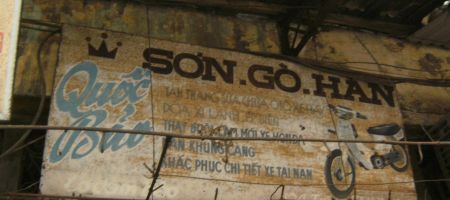
Old advertisement for the most popular moto that can be seen on the road nowadays. What is for the Thais the Honda Wave, in Vietnam, it is the Honda Super Cub. Reliable and cheap.
In Vietnam on the other hand, the major part of the traffic consists of motos. Comparatively only few cars or buses are driven on the street, surrounded by a swarm of motos. They really do move like a swarm of fish as they deftly move around obstacles like potholes or rubble.
And when crossing the street, you have to be that rubble (you can also be a pothole if you want) – move slowly and predictable straight over the street and the swarm will aptly avoid you. No “get off the road!” honking involved as one might expect it if you attempted the same thing in Germany.
Because zebra crossings are ignored and traffic lights are rare (and pedestrians ignored by cars turning left or right), this is also your only option as the stream of motos and cars will never end on the busy streets.
Naturally, most families just own a motorcycle and bicycles instead of a car. Just search google and you know that one motorcycle is enough for everything. Also, some of the normal roads here are actually closed for cars or only allowed as a oneway street.
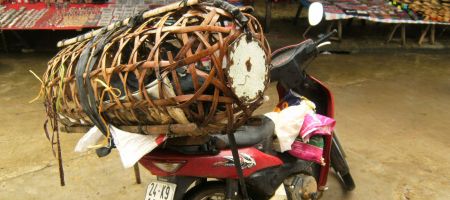
Transporter for about a dozen chicken or so.
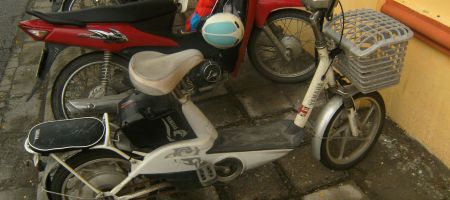
These Chinese-made elektro-bikes are quite popular in Hai Phong (not so much in Hanoi) as city-motos.
And there is no cheaper way. They don’t have this problem here with big cars with bust just one driver inside blocking the roads, parking lots (and costing fuel). No wonder why there is practically no (proper) public transportation within the cities when everybody has a personal horse at disposal or, if not, it will not be a problem to find someone who takes you.

Off to Vietnam
I’m off to Vietnam for a month now, I’ll write you there, probably!
Comment [2]

Thai Religion
Part I: My spirits fancy straws
Part II: Big Business
Part III: Thai Religion
Here is what I learned (and remember) what Buddhism in India is about:
Buddhism is based on the belief of the wheel of life, the belief in being damned to be born over and over again. Buddha showed a path to escape this vicious cycle by the realization that this world is false, by “waking up”, being enlightened. To be enlightened, to dissolve yourself into the universal being that encompasses and is everything, one has to detach himself from the world and from himself. It takes a lot of self-discipline and commitment but it is far from impossible.
So, Buddha achieved a state of mind for himself with a certainty of his whereabouts in the afterlife and his teachings aim to show a path for others to achieve this as well. So, he specifically did not want to be prayed to as a deity, he even said that no images of himself should be made out of this reason. A practice that Buddhist elsewhere nowadays justify by needing something to focus their concentration on while meditating (that’s what I heard).
In Thai Buddhism, this is just blatantly ignored.
The common people who go into a temple, do exactly that: Kneel before and worship Buddha. As from what I understand, the common people leave it to the monks to strive for enlightenment and instead collect karma points in order to have good luck in this life and be born into a better position in the next one as it is impossible to be enlightened from their position anyway (see below).
It is common that every male had been served at least a few weeks in a monastery as a monk during childhood. This, so I have been told, will help to get the parents into heaven in their next life.
And the temples? As there are not so much else to give respects to other than perhaps a few statues of famous monks, they are absolutely stuffed with Buddha statues in all different sizes, literally from the floor to the ceiling. And all of them golden and some of them simply megalomanic. I suspect that the reason for Thais making temples look like a treasure cove from the inside comes from the Chinese influence. As you see from the photo from the Chinese temple below, they also like gold.
Once though, I saw a big advertisement on the highway stating “Stop disrespecting Buddha. Stop creating images of Buddha” (or something similar to that).
Whenever I enter those places, I get the impression that the primary objective of this swank is to demonstrate wealth and power, not offer a place to focus your attention on meditation. But well, on this point this might very well be true out of the simple reason that meditation is not thought of being something a commoner, a visitor to the temple, would do but only the monks living there. So the meditation will be done somewhere else in the monastery.
This is because in Thai Buddhism the understanding is that it is next to impossible to reach enlightenment, that it takes many many lifes being committed to the path. Someone told me that it happens so rarely that there are official lists with monks who reached Nirvana. Those enlightened monks are worshiped like the saints in Christian belief.
Buddhism reached the area that we know as Thailand today only less than thousand years ago when the first Thai kingdoms emerged. And according to the official Thai history, Thailand has only been settled by many in recent times, mostly from immigrants from Chinese regions, but also from India, todays Myanmar and Cambodia. And all of those brought in their own religions.
All of these seem to have been merged into that hotpot that can aptly be called “Thai religion” rather than Buddhism. Near the entrance of temples, often a (golden) statue of Ganesha the elephant god, can be found. Sometimes, as in the photo below, shrines for Chinese gods are embedded into the temple. Animism, Hinduism, Chinese religious practices, the tendency to be extremely submissive1 and the Buddhist religion can all be found in todays practices of Thai people who call themselves Buddhists.
In my eyes though, Buddhism as such is not a religion anyway. As so many other beliefs, it only has been made into one. But what is religion? Religion is only the man-made organization built around a belief. And this organization imposes a hierarchy and seeks power and control over people. A powerful instrument to establish social control but in my opinion not a legitimate one as any power that maintains control over people must be legitimated by the people, and only by the people.
It is one thing to build a golden treasure cove, another thing to make them all kneel before that because it happens to be in the shape of what they worship. Just imagine the power you can exert over the people if you put yourself on top of that hierarchy constructed by (the organization:) religion. If you are above the most well respected and worshiped monks, what does it make you?
Now. Guess. Who is the religious leader of the Thai Buddhism?
1 Already the first European explorers who visited Thailand wrote that the Thai people are the most grovelling people they have ever seen. In front of their king, they grovel in the dirt. Where does this come from? I have no idea.

Big Business
Part I: My spirits fancy straws
Part II: Big Business
Part III: Thai Religion
The belief in spirits is not the only thing carried over from archaic religions. Particularly often near or sometimes even inside Buddhist monasteries, there are amulet markets where various talismans and other lucky charms are being sold. Many of these talismans are Buddha figurines, but also tiny framed pictures of famous monks are popular.
If a talisman is blessed by a monk, it increases its value somewhat depending on the status of the monk who blessed it. All with proper certificates of course.
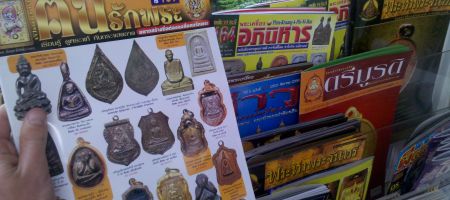
I took this picture in a 7-Eleven supermarket, those supermarkets are around every corner. The trade with talismans is so big, there are even magazines about it. There is a whole science connected with talismans which is not just about the value and the effect it is said to have but also there are delicate rules how you treat the talismans, otherwise they could loose their power.
But monks do not only earn money by blessing amulets, whole cars can be blessed as well to protect them from accidents. 1
On the topic of Thai spirit houses, the Wikipedia (currently) has to say that this is an animist belief that is tolerated nowadays by Buddhism in Thailand. But what I saw so far, it is not tolerated at all. No, it is part of the religion and in Thailand even though it is not a Buddhist thing, the Buddhist monks actively participate in it.
Good money, as well. And on the topic of amulets, I claim that they almost run the thing.
And all this business is kinda problematic because actually, monks may not have or use any money.2 Something the Thais are very particular about. Recently there had been scandals of high-ranked monks being accused to disrespect that law, one was accused to own an airplane and several houses in the USA.
Instead of giving money, there is the practice of giving food and everyday items to the monks. Buddhist monks do not beg, people give them food and all the other things they need in order to improve their own karma. This is common in Buddhism. As Thailand is a modern capitalist country, this kinda got streamlined into the product of those “orange buckets”, in cities at least.
These orange buckets are conveniently pre-packaged offerings that contain everyday products for monks. Depending on the “brand”, sometimes included are also things like flashlights and other non-disposable stuff where I start asking myself how many flashlights they might (have to) “consume” per day. They can be bought in many convenience stores, supermarkets and, interestingly, sometimes right in front of the temple on monastery premises.
Rumor has it, that they don’t open many of the buckets anymore but sell them back to the shops to buy something more useful (like rice, maintenance costs for the buildings etc.). It is only a rumor because Buddhist monasteries plus money is kind of a taboo even though everyone (should) know it is hard to do without.
1 A practice though that can’t be said to be unique in Thai culture (scroll down).
2 Buddhist monks should not use any money because enjoying luxury or involving yourself in any kind of trade distracts you from the path to enlightenment. Christian monks should not have any money because it makes you corrupt.

My spirits fancy straws
Part I: My spirits fancy straws
Part II: Big Business
Part III: Thai Religion
Religion is amongst my favourite topics to write about. But it is also one of the most difficult ones. It’s hard to wrap yourself around it and I don’t want to jump to conclusions too quickly.
In India, when I asked people about some aspects of their religion, they gave me at least a half-decent explanation or told me a story about it. In Thailand, the religion is in my opinion much less … approachable because it is less apparent, there is the language barrier and it is interwoven with this whole submissiveness and hierarchy shit they practice here.
Recently I walked into a 7-Eleven mini-supermarket and saw some small shrine on top of a cupboard behind the cashier’s counter. It consisted of a few open red Fanta bottles with straws inside and some religious decoration around it.
I asked what this is for but the only answer I got from them after minutes of discussion in Thai amongst each other was “Religion of Thai people”. In general they seem to be embarrassed even to be asked about such things. And to embarrass someone or to make him feel insecure is considered rude – as Lena never misses to point out to me.
By the way, I already figured out what the shrine was for from what Lena told me about it but I would have liked to hear it from them first-hand:
Those are offerings to the spirits of the house. A tribute to the spirits to leave the humans alone. Spirits like blood, that is why they fancy the red Fanta (strawberry flavour in case you wonder) because apparently they mistake it for blood.
Spirits live in every house occupied by humans, they are not the ghosts from the deceased but ferocious beings which must be appeased or fooled. (And fooling them seems to be quite easy.)
Spirit houses are a common sight in Thailand. These miniature houses are often found in front of family houses and yes, also sometimes in front of Buddhist temples.
I did not find out the reason for the little statuettes in and around the spirit houses yet, do they resemble or somehow imprison the spirits? Or do they “serve” the spirits like the Egyptian Ushabti served in the afterlife? Or something else entirely? What’s the deal with those statuettes of those happy-baby-monks? Are these perhaps just the Thai counterpart to the German garden gnomes?
And the reason for the straws? Well, that one is easy actually. Thais simply put straws in everything!
Bought a can of Coke? Here is your straw with it.
Buying a litre of milk? Don’t forget your straw!
You ordered a beer, Mister? There you are, and here is your straw!1
No reason to make an exception for the bottle of blood offered to the spirits, is there? Who knows, perhaps the spirit will even get suspicious about the nature of that “blood” if there is no straw in the bottle.
In reality, ants do really fancy the red Fanta and use the straws to climb down the bottle, rats and other vermin take care of the rest at night until it is replaced with new offerings.
But these animist practices are all quite unusual if you note that the state religion of Thailand is Buddhism, isn’t it? “Buddhism” in Thailand is not at all like what I learned it to be in India and Nepal. But well, more on that next time…2
1 Bought half a dozen of yoghurt cups for home? Here are your half a dozen disposable plastic spoons with it!
2 See the orange bucket on top of the cupboard on the first photo? This will be a topic in the next article about religion.

